2009 DODGE CHARGER radiator cap
[x] Cancel search: radiator capPage 399 of 484
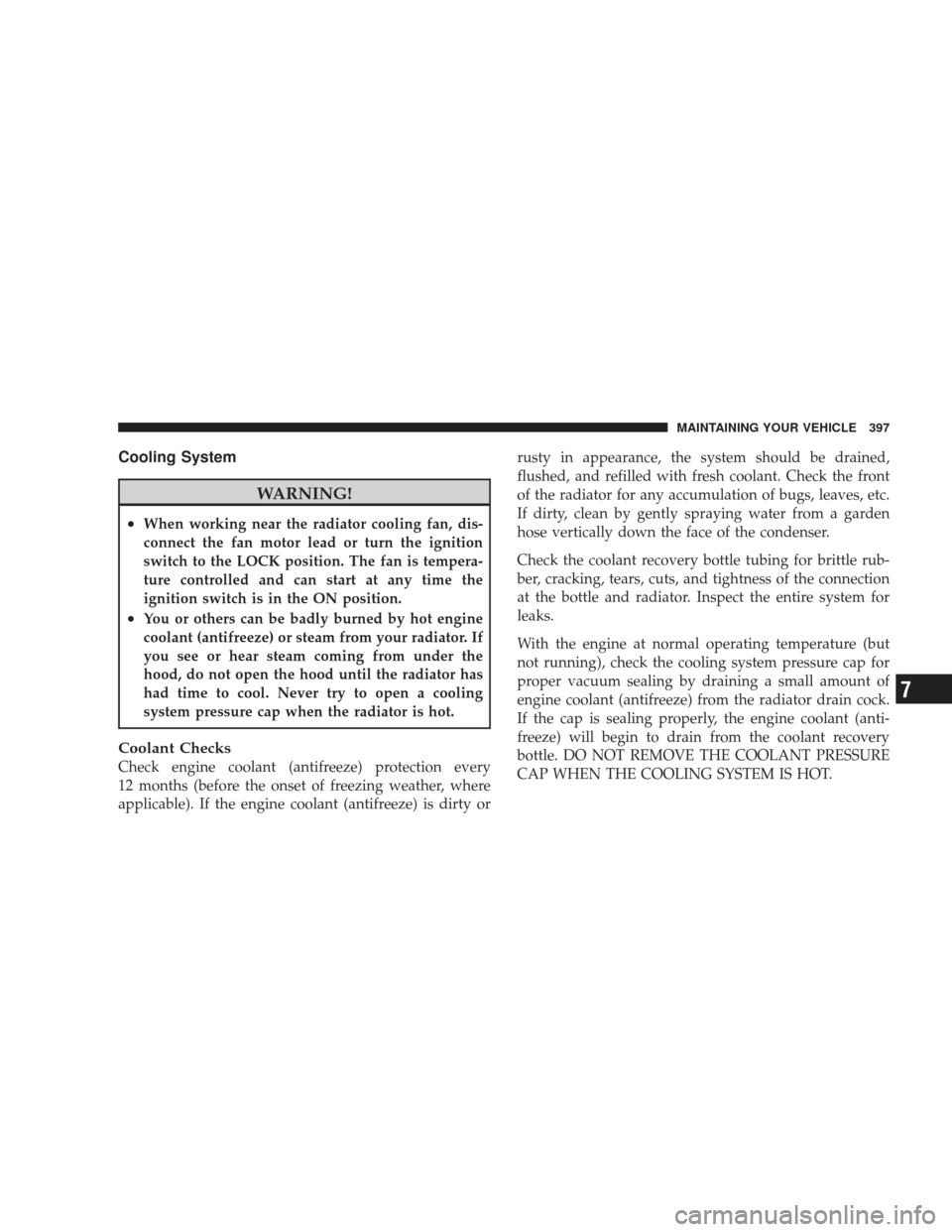
Cooling System
WARNING!
•When working near the radiator cooling fan, dis-
connect the fan motor lead or turn the ignition
switch to the LOCK position. The fan is tempera-
ture controlled and can start at any time the
ignition switch is in the ON position.
•You or others can be badly burned by hot engine
coolant (antifreeze) or steam from your radiator. If
you see or hear steam coming from under the
hood, do not open the hood until the radiator has
had time to cool. Never try to open a cooling
system pressure cap when the radiator is hot.
Coolant Checks
Check engine coolant (antifreeze) protection every
12 months (before the onset of freezing weather, where
applicable). If the engine coolant (antifreeze) is dirty orrusty in appearance, the system should be drained,
flushed, and refilled with fresh coolant. Check the front
of the radiator for any accumulation of bugs, leaves, etc.
If dirty, clean by gently spraying water from a garden
hose vertically down the face of the condenser.
Check the coolant recovery bottle tubing for brittle rub-
ber, cracking, tears, cuts, and tightness of the connection
at the bottle and radiator. Inspect the entire system for
leaks.
With the engine at normal operating temperature (but
not running), check the cooling system pressure cap for
proper vacuum sealing by draining a small amount of
engine coolant (antifreeze) from the radiator drain cock.
If the cap is sealing properly, the engine coolant (anti-
freeze) will begin to drain from the coolant recovery
bottle. DO NOT REMOVE THE COOLANT PRESSURE
CAP WHEN THE COOLING SYSTEM IS HOT.
MAINTAINING YOUR VEHICLE 397
7
Page 402 of 484

NOTE:Mixing engine coolant (antifreeze) types will
decrease the life of the engine coolant (antifreeze) and
will require more frequent engine coolant (antifreeze)
changes.
Cooling System Pressure Cap
The cap must be fully tightened to prevent loss of
coolant, and to ensure that engine coolant (antifreeze)
will return to the radiator from the coolant recovery
bottle.
The cap should be inspected and cleaned if there is any
accumulation of foreign material on the sealing surfaces.
WARNING!
•The warning words “DO NOT OPEN HOT” on
the cooling system pressure cap are a safety pre-
caution. Never add engine coolant (antifreeze)
when the engine is overheated. Do not loosen or
remove the cap to cool an overheated engine. Heat
causes pressure to build up in the cooling system.
To prevent scalding or injury, do not remove the
pressure cap while the system is hot or under
pressure.
•Do not use a pressure cap other than the one
specified for your vehicle. Personal injury or en-
gine damage may result.
Disposal of Used Coolant
Used ethylene glycol-based engine coolant (antifreeze) is
a regulated substance requiring proper disposal. Check
with your local authorities to determine the disposal
400 MAINTAINING YOUR VEHICLE
Page 403 of 484
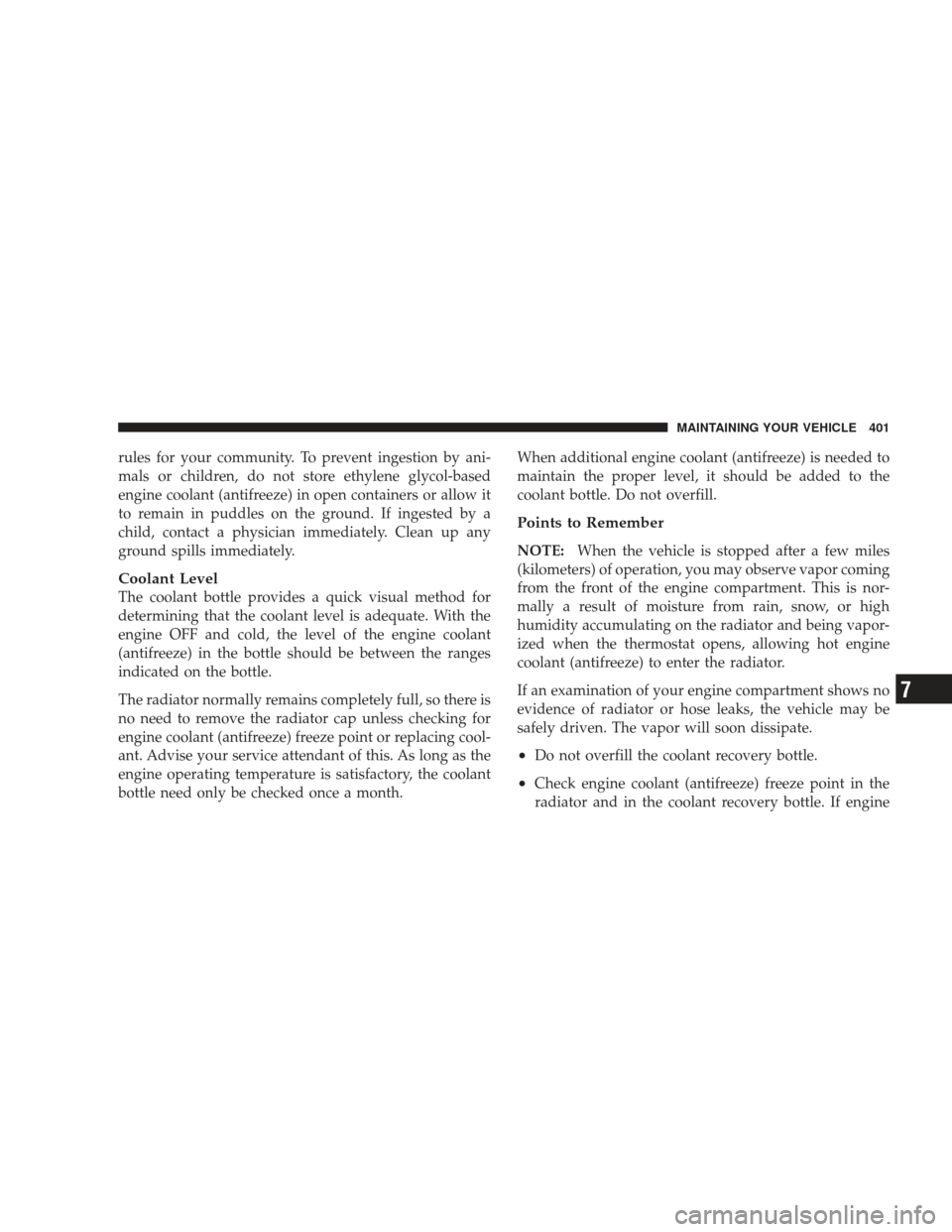
rules for your community. To prevent ingestion by ani-
mals or children, do not store ethylene glycol-based
engine coolant (antifreeze) in open containers or allow it
to remain in puddles on the ground. If ingested by a
child, contact a physician immediately. Clean up any
ground spills immediately.
Coolant Level
The coolant bottle provides a quick visual method for
determining that the coolant level is adequate. With the
engine OFF and cold, the level of the engine coolant
(antifreeze) in the bottle should be between the ranges
indicated on the bottle.
The radiator normally remains completely full, so there is
no need to remove the radiator cap unless checking for
engine coolant (antifreeze) freeze point or replacing cool-
ant. Advise your service attendant of this. As long as the
engine operating temperature is satisfactory, the coolant
bottle need only be checked once a month.When additional engine coolant (antifreeze) is needed to
maintain the proper level, it should be added to the
coolant bottle. Do not overfill.
Points to Remember
NOTE:
When the vehicle is stopped after a few miles
(kilometers) of operation, you may observe vapor coming
from the front of the engine compartment. This is nor-
mally a result of moisture from rain, snow, or high
humidity accumulating on the radiator and being vapor-
ized when the thermostat opens, allowing hot engine
coolant (antifreeze) to enter the radiator.
If an examination of your engine compartment shows no
evidence of radiator or hose leaks, the vehicle may be
safely driven. The vapor will soon dissipate.
•Do not overfill the coolant recovery bottle.
•Check engine coolant (antifreeze) freeze point in the
radiator and in the coolant recovery bottle. If engine
MAINTAINING YOUR VEHICLE 401
7
Page 404 of 484
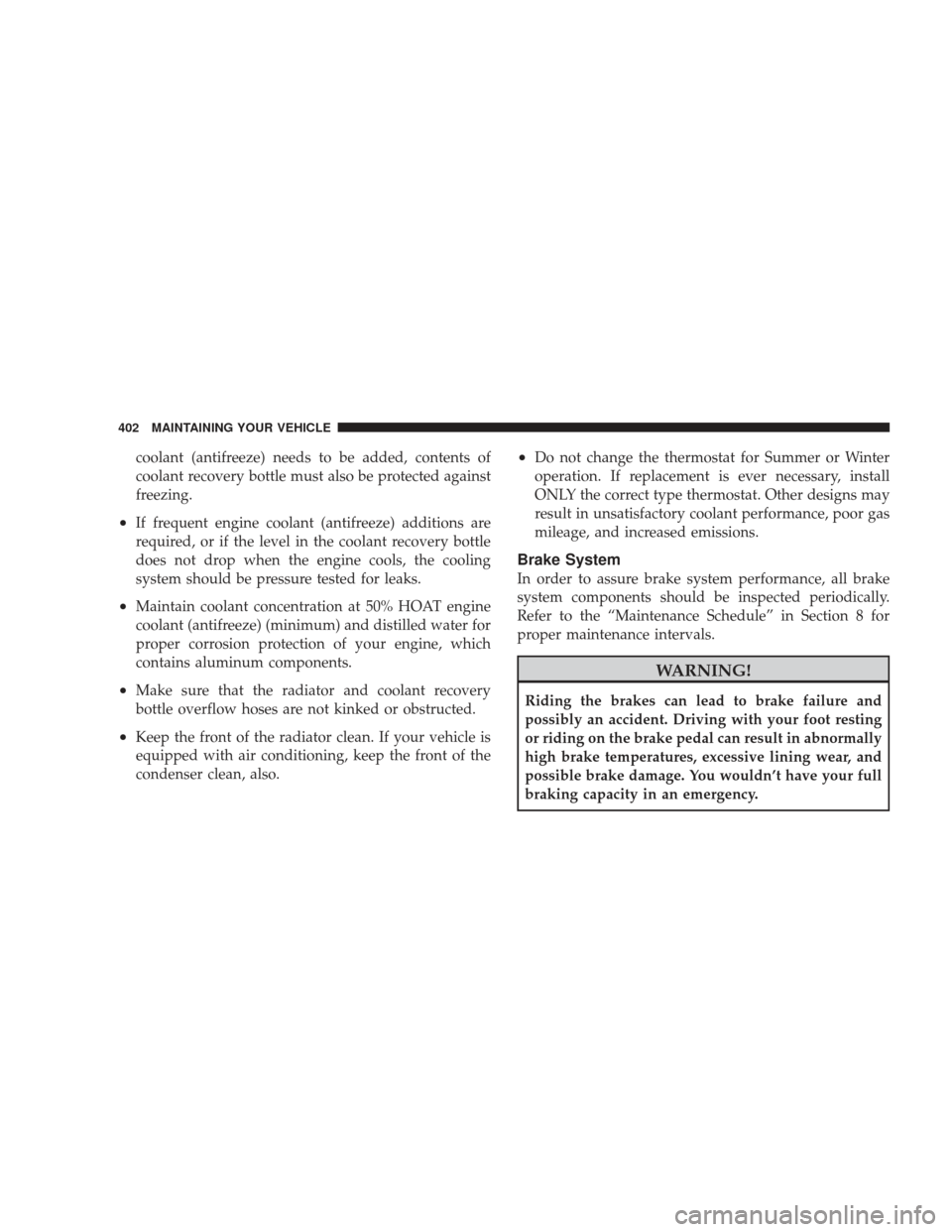
coolant (antifreeze) needs to be added, contents of
coolant recovery bottle must also be protected against
freezing.
•If frequent engine coolant (antifreeze) additions are
required, or if the level in the coolant recovery bottle
does not drop when the engine cools, the cooling
system should be pressure tested for leaks.
•Maintain coolant concentration at 50% HOAT engine
coolant (antifreeze) (minimum) and distilled water for
proper corrosion protection of your engine, which
contains aluminum components.
•Make sure that the radiator and coolant recovery
bottle overflow hoses are not kinked or obstructed.
•Keep the front of the radiator clean. If your vehicle is
equipped with air conditioning, keep the front of the
condenser clean, also.
•Do not change the thermostat for Summer or Winter
operation. If replacement is ever necessary, install
ONLY the correct type thermostat. Other designs may
result in unsatisfactory coolant performance, poor gas
mileage, and increased emissions.
Brake System
In order to assure brake system performance, all brake
system components should be inspected periodically.
Refer to the “Maintenance Schedule” in Section 8 for
proper maintenance intervals.
WARNING!
Riding the brakes can lead to brake failure and
possibly an accident. Driving with your foot resting
or riding on the brake pedal can result in abnormally
high brake temperatures, excessive lining wear, and
possible brake damage. You wouldn’t have your full
braking capacity in an emergency.
402 MAINTAINING YOUR VEHICLE
Page 464 of 484
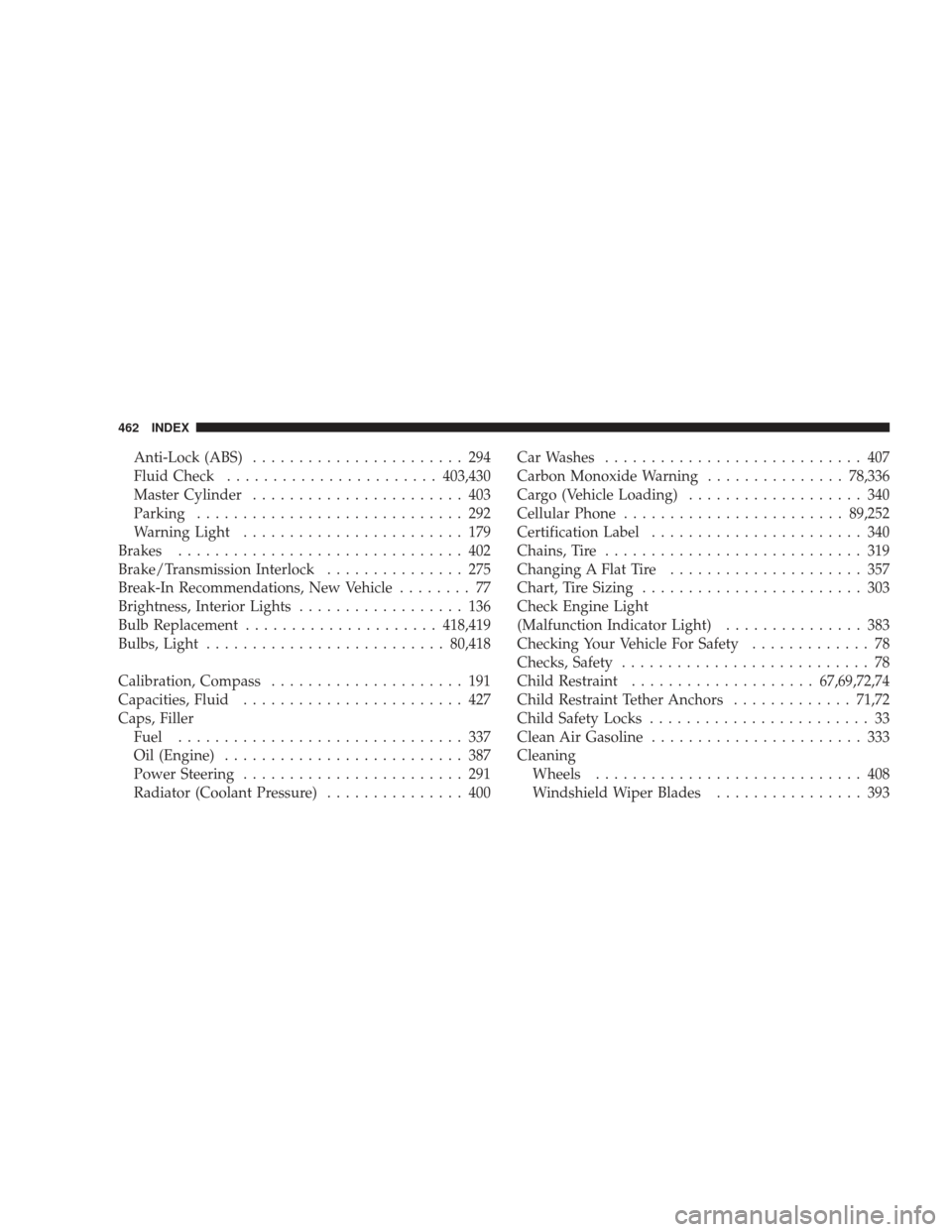
Anti-Lock (ABS)....................... 294
Fluid Check ....................... 403,430
Master Cylinder ....................... 403
Parking ............................. 292
Warning Light ........................ 179
Brakes ............................... 402
Brake/Transmission Interlock ............... 275
Break-In Recommendations, New Vehicle ........ 77
Brightness, Interior Lights .................. 136
Bulb Replacement ..................... 418,419
Bulbs, Light .......................... 80,418
Calibration, Compass ..................... 191
Capacities, Fluid ........................ 427
Caps, Filler Fuel ............................... 337
Oil (Engine) .......................... 387
Power Steering ........................ 291
Radiator (Coolant Pressure) ............... 400Car Washes
............................ 407
Carbon Monoxide Warning ...............78,336
Cargo (Vehicle Loading) ................... 340
Cellular Phone ........................ 89,252
Certification Label ....................... 340
Chains, Tire ............................ 319
Changing A Flat Tire ..................... 357
Chart, Tire Sizing ........................ 303
Check Engine Light
(Malfunction Indicator Light) ............... 383
Checking Your Vehicle For Safety ............. 78
Checks, Safety ........................... 78
Child Restraint .................... 67,69,72,74
Child Restraint Tether Anchors .............71,72
Child Safety Locks ........................ 33
Clean Air Gasoline ....................... 333
Cleaning Wheels ............................. 408
Windshield Wiper Blades ................ 393
462 INDEX
Page 465 of 484
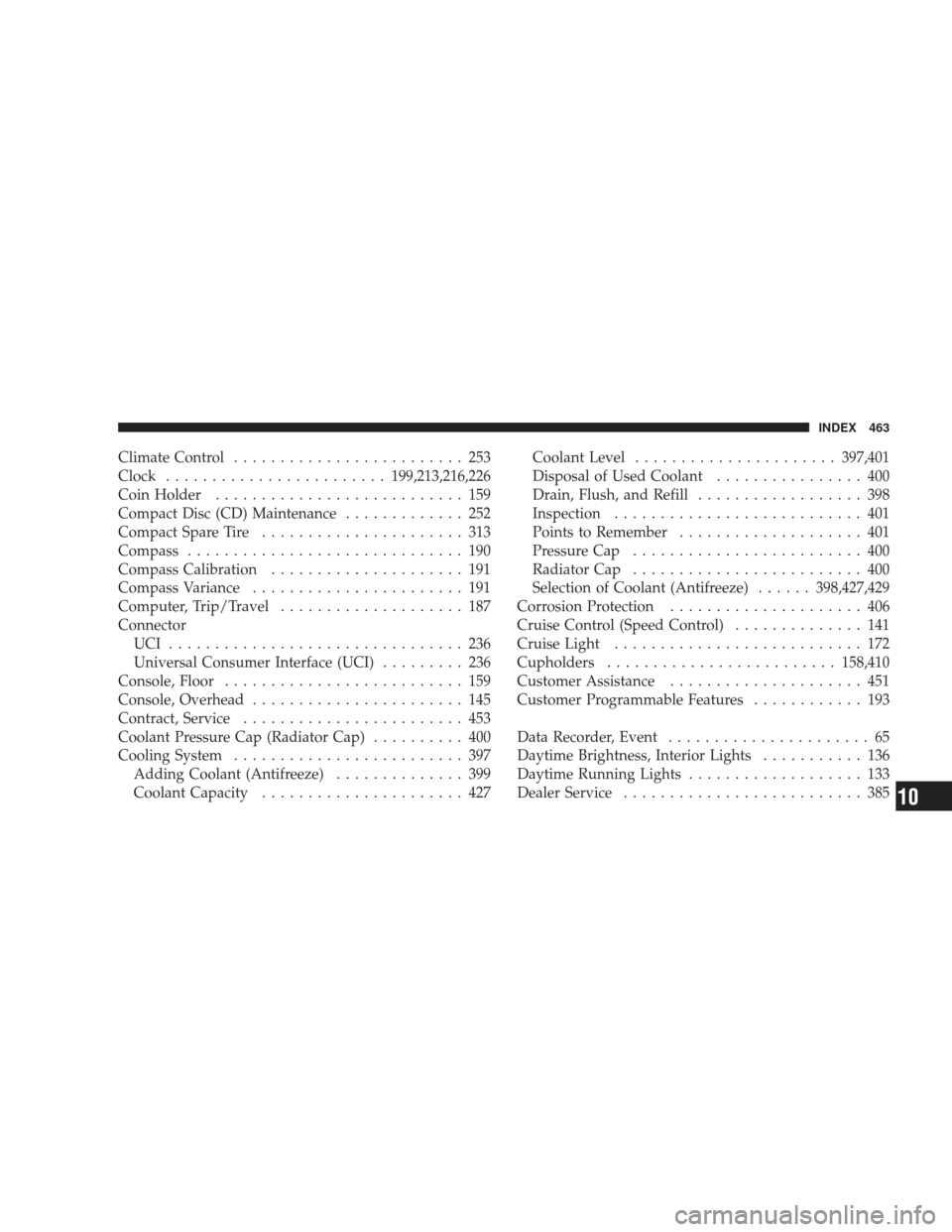
Climate Control......................... 253
Clock ........................ 199,213,216,226
Coin Holder ........................... 159
Compact Disc (CD) Maintenance ............. 252
Compact Spare Tire ...................... 313
Compass .............................. 190
Compass Calibration ..................... 191
Compass Variance ....................... 191
Computer, Trip/Travel .................... 187
Connector UCI ................................ 236
Universal Consumer Interface (UCI) ......... 236
Console, Floor .......................... 159
Console, Overhead ....................... 145
Contract, Service ........................ 453
Coolant Pressure Cap (Radiator Cap) .......... 400
Cooling System ......................... 397
Adding Coolant (Antifreeze) .............. 399
Coolant Capacity ...................... 427 Coolant Level
...................... 397,401
Disposal of Used Coolant ................ 400
Drain, Flush, and Refill .................. 398
Inspection ........................... 401
Points to Remember .................... 401
Pressure Cap ......................... 400
Radiator Cap ......................... 400
Selection of Coolant (Antifreeze) ......398,427,429
Corrosion Protection ..................... 406
Cruise Control (Speed Control) .............. 141
Cruise Light ........................... 172
Cupholders ......................... 158,410
Customer Assistance ..................... 451
Customer Programmable Features ............ 193
Data Recorder, Event ...................... 65
Daytime Brightness, Interior Lights ........... 136
Daytime Running Lights ................... 133
Dealer Service .......................... 385
INDEX 463
10
Page 475 of 484
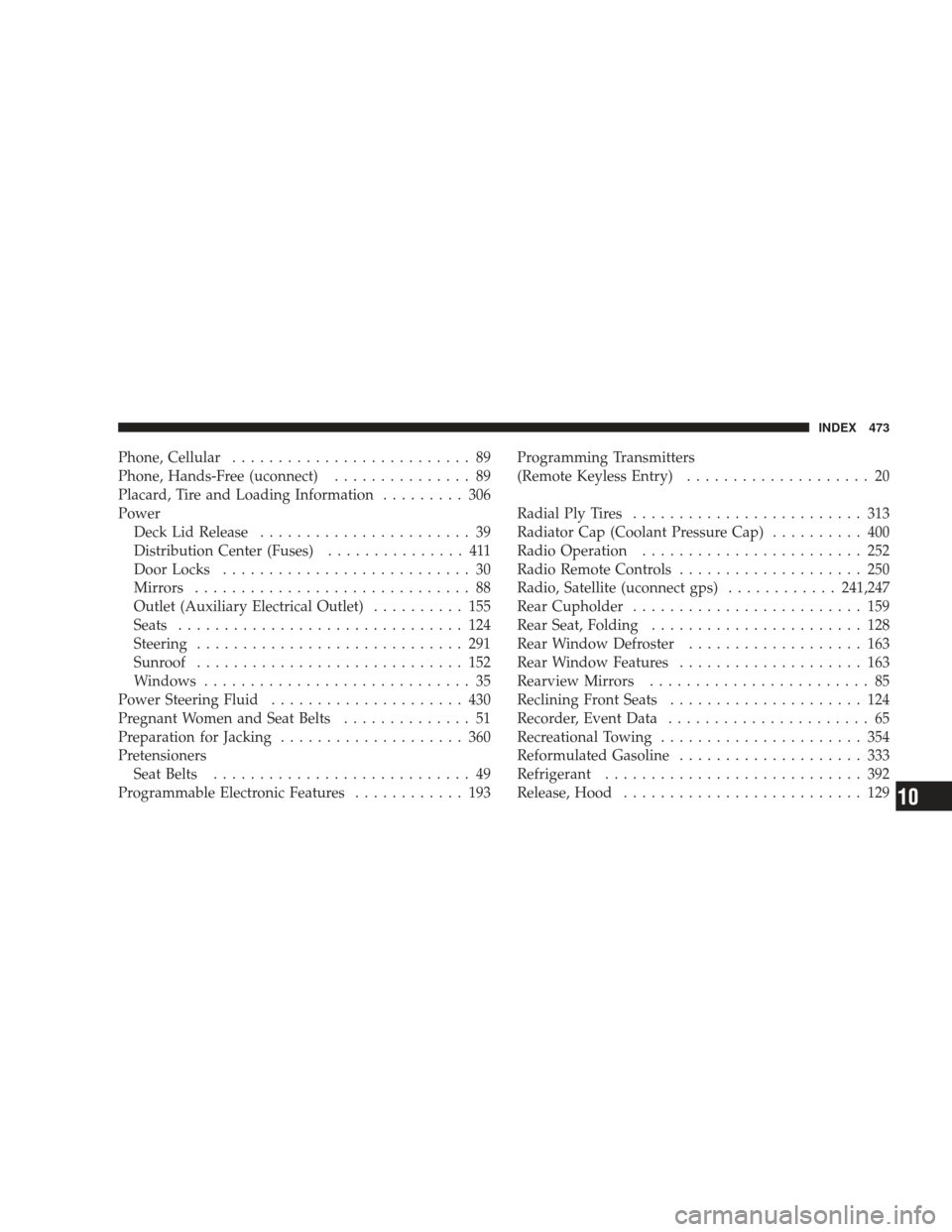
Phone, Cellular.......................... 89
Phone, Hands-Free (uconnect) ............... 89
Placard, Tire and Loading Information ......... 306
Power Deck Lid Release ....................... 39
Distribution Center (Fuses) ............... 411
Door Locks ........................... 30
Mirrors .............................. 88
Outlet (Auxiliary Electrical Outlet) .......... 155
Seats ............................... 124
Steering ............................. 291
Sunroof ............................. 152
Windows ............................. 35
Power Steering Fluid ..................... 430
Pregnant Women and Seat Belts .............. 51
Preparation for Jacking .................... 360
Pretensioners Seat Belts ............................ 49
Programmable Electronic Features ............ 193Programming Transmitters
(Remote Keyless Entry)
.................... 20
Radial Ply Tires ......................... 313
Radiator Cap (Coolant Pressure Cap) .......... 400
Radio Operation ........................ 252
Radio Remote Controls .................... 250
Radio, Satellite (uconnect gps) ............241,247
Rear Cupholder ......................... 159
Rear Seat, Folding ....................... 128
Rear Window Defroster ................... 163
Rear Window Features .................... 163
Rearview Mirrors ........................ 85
Reclining Front Seats ..................... 124
Recorder, Event Data ...................... 65
Recreational Towing ...................... 354
Reformulated Gasoline .................... 333
Refrigerant ............................ 392
Release, Hood .......................... 129
INDEX 473
10